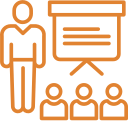Despite my friend’s response, becoming more agile is something we can all start doing today. Ahead of my session on March 23rd, here are three tips for HR professionals looking to add agility to their toolkit.
1. Clear your WIP
The Manifesto for Agile Software Development describes twelve principles, of which my favorite is simplicity. As the manifesto’s authors put it: “the art of maximizing the amount of work not done is essential.”
Once you’re ready to commit to an agile change mindset, you’ll need to continuously tend to your work in progress—like pruning a hedge—to make sure that your focus and throughput isn’t inhibited by too many concurrent projects. (After all, humans are proven to be incapable of multitasking.)
That idea is all well and good, but the reality is that most of us do have quite a lot of work in progress at any given moment—and, unfortunately, deciding to “go Agile” isn’t commonly accepted as a way to get out of prior work commitments.
So, where do you start? By putting down the pruning shears and picking up a hedge trimmer.
Today (right now, even!), you can take stock of all the work you currently have in progress. Look for ones that are blocked by other people, whether they are waiting on approval or pending input from SMEs. Put that work to the side.
Take a look at all the projects that are left and pick out one—just one—that is most important. Think of “important” as whatever will be most valuable to your organization and, more importantly, your learners. That’s your work in progress. That’s all you need to be working on right now.
Everything else? Move it to the side, and don’t touch it until you finish your work in progress.
2. Try Something New
You’ve decided which project is the most important for the day. Now, identify how you can experiment within that project.
Developing new training? Try building it as small chunks of microlearning. Preparing a report? Create it as a dynamic video instead.
The idea here is not to try something new just for novelty’s sake, nor is it to complicate a clear-cut task with extra effort. Instead, we’re looking for a way you can get new information out of the project you’re working on today.
Continuous learning is a central tenet of the Agile change mindset, and the best way to learn continuously is to experiment continuously. The sooner you can get something new in front of your learners or audience, the sooner you can learn from them about what works.
3. Keep Learning
If the Agile mindset is all about continuous learning, then it follows that the best thing you can do today is commit to learning about business agility.
Sign up for accredited agile training via ICAgile and grab a book from the Agile Alliance book shop!













